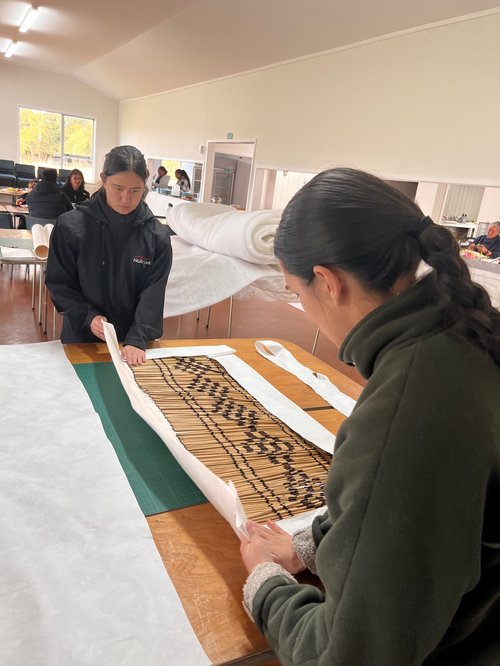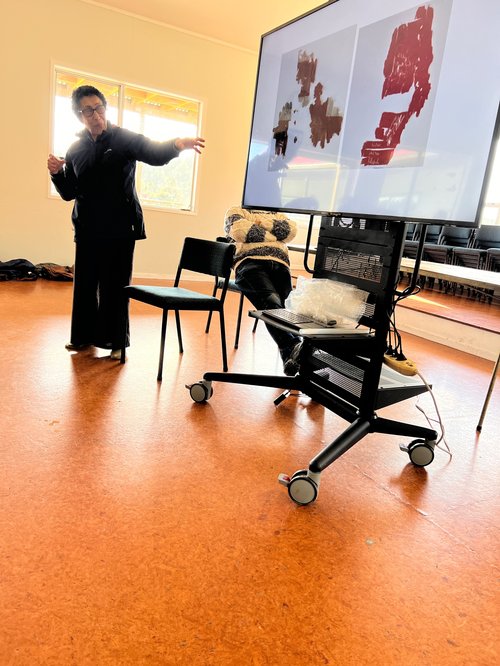
This kaitiaki wānanga based on Tuhirangi Marae was the final wānanga as part of the Te Awe Kotuku tahua pūtea. Te Papa and various partners in the GLAM (Galleries, Libraries, Archives and Museums) sector worked with the Taitokerau iwi Te Mahurehure, to organise this wānanga, where the people of Te Taitokerau could bring their taonga from their iwi and communities to Tuhirangi Marae to be restored. There were over 30 attendees to the wānanga, from all age groups, kuia kaumātua mai, rangatahi mai, taitamatāne, taimatawahine mai. Each brought beautiful taonga, that included korowai, a 100-year-old rāpaki, and kete. Many attendees brought taonga from their marae, others brought taonga from the local schools in the region.

Kaitiaki at the wānanga
Well-known tohunga in the art of weaving / raranga harakeke, Te Rangituatahi Te Kanawa, and conservation expert of whakairo / working with wood, Rose Evans, led the workshop. He wāhine whai mana te tokorua nei, these two brilliant tohunga have travelled Aotearoa, and across the world, repairing marae, waka, woven projects such as whāriki, woven sails, and kete. In this light they have created respectable reputations in the world of taonga conservation. During the wānanga Rangituatahi and Rose each shared great knowledge and specific treatment strategies regarding conserving taonga. They also provided resources which the attendees used to physically repair their taonga.

Kaitiaki carefully wrapping their taonga
Ko te wāhi ki au
I felt very honoured to be asked to be a part of this project as a representative of Ngā Taonga Sound & Vision. The purpose of my involvement was to repatriate audiovisual archives that belong to the people of Tuhirangi Marae. Leading up to the wānanga there were many hui that took place to plan what types of archival footage would be best suited to screen at the wānanga and furthermore give back to the iwi. The popular 1974 series Tangata Whenua was highly recommended, specifically the Turangawaewae episode that speaks of the people of Waimā. I also took a couple of audio archives of the Dog Tax War that affected the Waimā people, as well as an audio taonga that documented the occasion when taonga whakairo were returned back to Tuhirangi Marae.

Te Rangituatahi Te Kanawa
He kōpere tīwhanawhana
Not long after we checked into our hotel rooms, we got on the road to Tuhirangi Marae. We were told it was a 40-minute drive from Kerikeri. The landscape was picturesque, lush. Such beautiful whenua in this part of Te Aupouri I had never before explored, driving roads I had not yet set foot on, into valleys I had never set eyes upon. Knowing well I did my karakia before leaving the capital, I was nervous, aue, even the sky appeared to be different. I remember not even being able to point out which direction faced east, west, north or south. I jumped in with Paora Tibble from Te Papa. Paora seemed a little flustered, he was talking about some misunderstanding that occurred earlier with a hired vehicle, which he said eventually worked out. And for some reason he said, “It's all good e hoa, we done a karakia today.” Paora spoke in a tone that without even saying much, I could tell he had a million things on his mind. I said to him, “E hoa, everything is going to go well.” I pointed out my window, there across the paddocks a beautiful full arched rainbow beamed vividly high over the terrain. Which was the tohu (sign) I had been searching for, that reminded me that wherever this road takes me it's going to be to a place of great purpose.

Rose Evans and students
Taku manu Kārearea
Other tohu (signs) I recognised as we navigated this unknown whenua, were sightings of Kārearea, these manu are my kaitiaki. They soared in and out of sight over the top of the vehicle gliding graciously across the front windscreen. This manu has always been a kaitiaki of mine, this manu travels alongside me guiding my every movement. Seeing my manu on my travels assures me that our timing is perfect, and that we should be right on time or ahead of time. Most importantly, it confirms to me that I am in the right place at the right time.
Te Whare Karakia i Taheke Marae
We were well ahead of time, so on our way to Tuhirangi Marae, we made a stop to Taheke Marae, where we were invited to look at a rundown church that the people of Taheke plan to renovate and repurpose into a community centre. We entered, the church stood with a sturdy structure and the frame of the church still intact, the roof held out all leaks, it was worth saving. Rose Evans examined the church, being the Tohunga in this field of conservation working particularly with wood. She examined all the cracks and crevasses and discussed recommendations. It was quite impressive watching Rose share knowledge in this field, a field I have no expertise in.

Paora Tibble, Rose Evans and Paora Sweeney at Hokianga Harbour
Hokianga Whakapau Karakia – He tuku īnoi he Iriiri
We also made a stop to Hokianga Whakapau Karakia. It was a place I had only heard of and for many years I had wanted to make a trip there. I knew it was a spiritual place, and for me it meant more than a stopover. We parked the car, and Rose Evans said, “Let's all meet back here in a half an hour.” I said, “I’m going down to the moana.” The harbour itself was a sight to see. I recited the Paimarire, a karakia from home, to guide me on this journey, and did my iriiri (a practice that involves sprinkling or flicking water over myself, as a means of preparing myself and cleansing wairua) before returning to the car. Paora Tibble spoke of the two kaitiaki of the harbour, Araiteuru and Niwa, whom are the taniwha of the Hokianga Harbour, which is something new I could add to my learnings while on this adventure.
Tērā te uira e hikohiko rā, tērā te papaki o whaititiri e
We arrived just on nightfall, the rain now gushing down, where only a quarter of an hour prior, the sky was clear. We assembled at the mahau in front of the atea. There, we waited as other vehicles found parks and people eager to partake in the wānanga joined in our ope. Lawrence Wharerau explained the tikanga of the marae and agreed to do the wairea as we embarked on to the marae. A bright security night light shone from the whare we were minutes from entering, which lit up the path from the mahau to the whare tipuna, ka puta mai te ruruhi, ka timata te Karanga. As we walked into the marae guided by the karanga, the sky began to rumble, thundering a sound so great it was as if we were entering a sold-out concert where millions of voices roared, cheering us on. Lightning lit the sky so bright that the night flashed and for a brief second painted the sky white. The rain continued to soak the whenua. Lawrence recited the Wairea Karakia as a response to the ruruhi, which is the tikanga known to Te Taitokerau iwi kia whakatau manuhiri. Ka ekea te marae and we made our entrance into Tuhirangi Marae.

Under the mahau before Powhiri
The white cow, in the middle of the night
Once the formalities of the marae were finished, the plan for the first night was to get to know each other. We did a whakawhanaungatanga, a tu atu, tu mai approach where we each introduced ourselves to create a rapport and connect. Following a kai, the night wrapped up at around 10.30pm. We then closed the night in karakia. From there we each returned to our cars and headed back to our accommodation, in our case back to Kerikeri to our hotel room. The picturesque landscape was now consumed in darkness. The valley was now quiet, in some parts we were the only vehicle on the road. We continued into the night, the headlights on full beam, when suddenly in the middle of the road stood a large white creature of some sort, too large to be a dog or goat. We slowed down. As we got closer we realised it was a white cow blocking the road, staring faultlessly at us. I reached for my phone to take a photo to capture the moment and before I knew it the cow had gone. We looked around at each other amazed, ana kee ngā tohu. Paora Tibble pointed out the church we had visited earlier at Taheke Marae, which was the exact point we were miraculously stopped by the cow. The next day we told the iwi about our encounter with the cow, and I remember one of the rangatira of the pā saying, “That cow appearing was a tohu from us to let you know to never forget us.”
Nga Taonga kōrero me nga Taonga whitiāhua
It was an absolute pleasure to reconnect the people of Te Mahurehure to their taonga whitiahua, taonga korero that we hold in our collection. To have the opportunity to share taonga in the comforts of their ancestral lands was for me a magical experience. Leading up to the wānanga, I have to admit that I wasn't fully aware of history of the Waimā people, however I learned so much as we watched and listened to the content of each item. We held the screening in the wharekai of the Marae. My jaw dropped as the locals of Waimā shared the full context of the Spectrum episode of the Dog Tax War. They spoke of a law that was introduced by Government that said all those who owned a dog had to pay tax for the dog. Many people in the Waimā region owned dogs; some whānau had many dogs. When this law passed, of course many Māori whanau could not afford the tax, which led to their lands being confiscated.
The Te Hokinga Mai o nga Whakairo audio archive warmed my heart, as it was a broadcast of when whaikairo that once adorned their marae were returned to the iwi after many years being stored in Auckland. It was astounding to hear that these whakairo were now buried in front of this very marae. Members of the iwi pointed to the exact place where the buried taonga currently lie. Making these connections to the collection we hold at Ngā Taonga is for me the most rewarding part of this type of mahi. Paora Tibble and I stood back and briefly scanned the room, as the people of Te Mahurehure watched and listened to the taonga in awe. Paora Tibble leaned over my shoulder and said, “Look, they’re loving it.”
He Oti
Kei ngā maunga whakairi kōrero, Whakatere Manawa Kaiaia.
Kei te awa māpuna o Moehau e karekare atu rā ko te wai tuku kiri.
Whakawhiti atu rā ki te moana o Hokianga Whakapau Karakia, e teretere nei ngā Taniwha i te rua, ko Āraiteuru, ko Niwa.
Kīhai i ārikarika te reo whakamiha. Āno te pai, anō te āhua reka o te noho tahi ki a koutou.
Kei te mana whakahaere Te Whare Tapu o Ngāpuhi ka puta ko ngā uri o Te Māhurehure nei ka mihi, nei ka mihi.
E tau ana.

Some of the attendees and their taonga